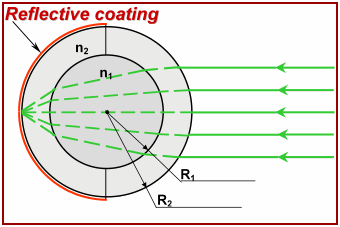
BLITS: Array Offset Information
BLITS
The figure below shows the optical layout of the BLITS retroreflector.

The total optical path length inside the glass sphere is:
L0 = 2R1n1 + 2(R2-R1)n2
where n1 = 1.8675(at +20°C and λ=532nm) is the group refraction index of the inner flint glass ball having a radius of R1=53.52mm, and n2=1.4986(at +20°C and λ=532nm) is the group refraction index of the outer crown glass layer having an external radius of R2=85.16mm.
The geometrical path length of the laser light from the incidence point to the ball center is equal to the radius R2. Thus, the correction value is:
L0-R2 = 2R1n1 +2R2n2 -2R1n2 -R= 199.90 + 255.24 – 160.41 - 85.16 = 209.6 mm
Thus to correct the measured one-way laser range to the center of mass of the satellite, 209.6 mm should be SUBTRACTED from that measured one-way range.
The calculated correction value variation caused by the glass refraction indexes temperature dependence is less than 0.1 mm with in a temperature range of ± 35°C (relative to +20°C).
BLITS-M
The mission has specified a value of 272.6 mm as the center-of-mass correction for the BLITS-M satellite.






